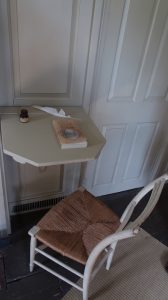 “…there was, in the rear of the house, the most delightful little nook of a study that ever afforded its snug seclusion to a scholar….” Nathaniel Hawthorne, from “The Old Manse.”
“…there was, in the rear of the house, the most delightful little nook of a study that ever afforded its snug seclusion to a scholar….” Nathaniel Hawthorne, from “The Old Manse.”
The study Hawthorne describes overlooks a splendid New England landscape of orchards, rolling fields and the Concord River. Two great writers found inspiration in this study, according to The Old Manse website. Hawthorne and Ralph Waldo Emerson each occupied the house but at different times. There was a marked difference, however, in the way each used this “delightful little nook.” Emerson’s desk was in front of the window and looked out on those fields and the meandering river, surely an inspiration for his poems and essays and reflections. I can imagine the essay “Nature” was composed at that desk.
But Hawthorne? His writing table faced the wall.
The Old Manse website explains this by describing Hawthorne as shy. But I believe they’re wrong. Why? Because Hawthorne wrote fiction.
Note The Paris Review’s description of contemporary novelist Jonathan Franzen’s creative space: “Situated amid redwoods on the mountain rim above Santa Cruz and Monterey Bay, the office would have offered an ocean view, but a makeshift arrangement of towels, bedsheets, and pillows had been engineered to block out the combined dangers of light and distraction.”
My own desk sits beside a window with drawn blinds. It faces a wall. Those who write fiction don’t have to have inspirational vistas. The imagination provides.
